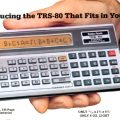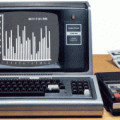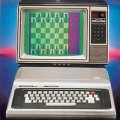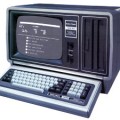The TRS-80 Pocket Computer 2
The TRS-80 Pocket Computer 2 (catalog number 26-3601), better known as the PC-2 (and even the Pocket Computer II in some early articles), was the most powerful member of Radio Shack’s family of Pocket Computers. The PC-2 wasn’t a replacement for the original Pocket Computer (known as the PC-1), but served as a more advanced (and more expensive) alternative.
The PC-2 cost $279.95 when it was introduced in 1982, but that price dropped to $199.95 by the following year. It was the only Pocket Computer that had speed and memory capacity that was competitive with a contemporary desktop computer. The PC-2 wasn’t manufactured by Radio Shack, but was a rebadged Sharp PC-1500. It wasn’t compatible with any of the hardware or software Radio Shack sold for the PC-1.
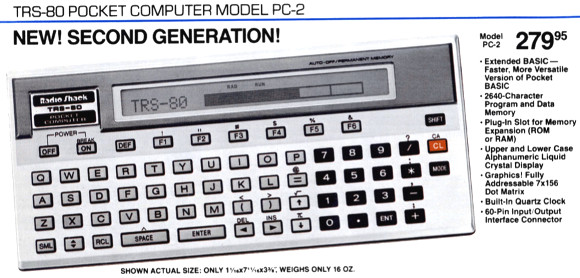
The PC-2 from a 1982 Radio Shack catalog
Specifications
The PC-2 was larger and heavier than the PC-1. It measured 7 11/16" by 3 1/8" by 1 1/16", nearly one inch bigger in each dimension than the PC-11. It weighed 16 ounces (with batteries) compared to the six ounces of a PC-1. The extra width of the PC-2 meant that it could use ordinary AA batteries instead of the thin mercury coin cells of the PC-1. The PC-2 could run for 75 hours2 on four AA batteries and could also be powered by an optional DC adaptor.
The PC-2 had much better hardware specifications than the PC-1:
- a LH5801 processor operating at 1.3MHz
- a 26-character LCD display, with a resolution of 156 by 7
- a miniature 65-key QWERTY keyboard
- a speaker for generating tones
- a real time clock
- a 16K ROM BASIC, known as “Extended Pocket BASIC”
- a “2640-character program and data memory,” which meant slightly over 2K for BASIC programs
- a 60-pin Input/Output Interface Connector for connecting peripherals
- a plug-in slot for memory expansion, capable of accepting up to a 16K module
For the memory expansion slot, Radio Shack sold a 4K RAM module (catalog number 26-3615) for $69.95 and an 8K RAM module (catalog number 26-3616) for $139.95. In a 1982 article in the TRS-80 Microcomputer News, a 16K module was described as being “a minimum of one to two years away.” Radio Shack never sold a 16K memory module, although Sharp did later sell one for their PC-15003.
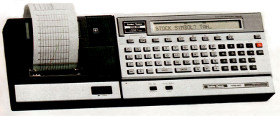
The PC-2 Printer/Plotter/Dual Cassette Interface from a 1983 Radio Shack catalog
Accessories
Probably the most common PC-2 accessory was the PC-2 Cassette/Printer Interface (catalog number 26-3605), later renamed the PC-2 Printer/Plotter/Dual Cassette Interface. It originally cost $239.95 but that price was soon reduced to $219.95. The Printer/Plotter/Dual Cassette Interface was larger than the PC-2 and contained its own rechargeable batteries. The PC-2 fit into it and was powered by its batteries while connected.
The Printer/Plotter/Dual Cassette Interface added 25 commands to PC-2 Extended Pocket BASIC to control the cassette and printer. As the name suggested, it supported two cassette recorders. This allowed (according to a Radio Shack catalog) “data to be read in from one cassette, updated and stored on a second cassette — all automatically under program control.” The plotter printer could print “graphics and alphanumerics in green, red, blue, and black.” Also according to the catalog:
You can plot superbly detailed 256 x 2096 XY four-color graphics, and print upper and lower case characters in nine different sizes using easily replaceable ballpoint mini-pens.
Radio Shack sold three replacement pens in red, blue, and green (catalog number 26-1481) for $2.95. Three black replacement pens (catalog number 26-1489) also cost $2.95. Radio Shack sold packages of 2 1/4" wide printer paper (catalog number 26-3606) of six rolls for $2.49.
Another PC-2 accessory was the RS-232C Interface (catalog number 26-3612), which cost $199.95. The RS-232C Interface added commands to Extended Pocket BASIC to allow the PC-2 to connect to most RS-232 devices. Amazingly, along with a modem it could be used to connect the PC-2 to online services such as Dow Jones and CompuServe.
Programming
The 16K Extended Pocket BASIC contained in the PC-2 was a very powerful version of BASIC, more comparable to Level II BASIC on a Model I. It offered arrays of two dimensions, strings of up to 80 characters, GCURSOR, GPRINT, and POINT for bitmapped graphics, BEEP (with parameters) for sound generation, and a TIME command to read the current time. It also had all of the mathematical commands of the earlier PC-1 BASIC.
The LH5801 processor used by the PC-2 was similar to the Zilog Z804 used on the desktop TRS-80 Model I. Extended Pocket BASIC contained PEEK and POKE commands and the PC-2 was the sole Pocket Computer that could be programmed directly in assembly language. The only available source of programming information5 was “PC-2 Assembly Language,” a series of articles written by Bruce Elliot for the TRS-80 Microcomputer News. This was stated in the introduction to the first article:
Please understand that the information provided in these articles is the only information which is available. We will try to clarify any ambiguities which occur in the articles, but can not reply to questions outside the scope of these articles. Further, published copies of TRS-80 Microcomputer News are the only source of this information, and we will not be maintaining back issues.
Software
None of the Radio Shack’s PC-1 software was compatible with the PC-2, but Radio Shack sold a number of new PC-2 software packages. Some of these included Math Pak I (catalog number 26-3709) and Math Pak II (catalog number 26-3710) for $14.95, Statistics (catalog number 26-3704) for $29.95, Chemistry/Math (catalog number 26-3708) for $14.95, and Personal Finance (catalog number 26-3700) for $14.95. They also sold some games, such as Invasion Force (catalog number 26-3705) for $9.95 and PC-2 Games Pak (catalog number 26-3702) for $14.95.
Discontinuation and the PC-1600
In late 1984, Radio Shack ran a final half-price sale on the PC-2 and its peripherals. The PC-2, the Printer/Plotter/Dual Cassette Interface, and the RS232C Interface all sold for $99.95 each. Radio Shack discontinued the PC-2 and peripherals soon after, presumably after they had sold out. Sharp continued to sell the PC-1500 until at least 1985 and introduced a more powerful successor, the PC-1600, in 1986. Radio Shack never sold a rebadged version of the PC-1600.
I suspect the high price of the PC-2, especially when combined with the price of the Printer/Plotter/Dual Cassette Interface, had a lot to do with its short lifespan. The PC-2 was very well liked by its owners, but a fully-equipped PC-2 cost hundreds of dollars more than an equivalent PC-1. This might have been one of the reasons Radio Shack’s Pocket Computer sales dropped dramatically (by over 40%) in 1983, the year after the PC-2 was introduced.
Radio Shack introduced six more Pocket Computers (including the excellent PC-4), but all were smaller, less expensive, and less powerful than the PC-2.
-
The larger size of the PC-2 (in particular the depth) meant that it was more difficult to fit in a pocket than the PC-1. ↩︎
-
75 hours is much less than the 300 hours of the PC-1, even though an AA battery has more energy than a coin cell. The faster processor speed of the PC-2 and resulting increased power demand was to blame for the difference. ↩︎
-
Sharp also sold a 32K memory module, with two switchable 16K banks, for the PC-1500 and PC-1600. ↩︎
-
Contrary to some sources, the LH5801 was only similar to the Z80. It wasn’t compatible with either Z80 binary or source code. ↩︎
-
There was also a technical reference manual for the PC-1500 from Sharp, but that wasn’t commonly known by PC-2 users at the time. ↩︎
